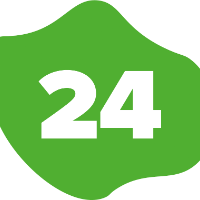Datasets
A planning dataset is the key object for your planning.
Go to the Datasets tab within the 24Planning app and click “New” on the top right.
The following settings apply when creating a new dataset:
General Settings
Name: Name of the data set.
Zoom Level: This is deprecated and no longer used in the app.
Weight: The weight determines the order in which datasets are shown in the dataset dropdown selector in the planning view.
Time Highlight Preset: Optional custom 24Planning object. Highlights are shown in the planning board, e.g. you can define a highlight to show public holidays in the planning board. See below for more details on Time Highlight Presets.
Available View Presets: Defines the time windows that will be visible to the planner in the planning board, e.g. day, week, 2-weeks, month, etc.
Default View Preset: Default time window that is used when the planning board is opened.
Unplanned Work Sidebar Open: Check this box in case you want the unplanned work sidebar to be opened by default in case Unplanned Events is enabled on a datasource.
Mark Current Time: Check this box in case you want a marker on the current day in the planning view.
Load Chunk Size: If there are a lot of resources to load, they are loaded sequentially in chunks. Leave the value to default unless you experience loading issues.
Public Groups: Salesforce Public Groups are configured in the Users > Public Groups section in Setup. In the context of DataSets, only users belonging the configured public groups will have access to the DataSet. If left empty, all users will have access to the DataSet.
Customizing the View Presets
It is possible to customize the view presets or even to create new ones.
https://youtu.be/n1nxHme74NQ?si=v9ij6HGHbHHDqU4ZNavigate to Setup > Custom Metadata Types. Click on Manage Records next to the 24Planning_View_Preset.
The following are the most relevant parameters that you can edit:
Tick Width: the time column width in the planning board.
Base: determines the visual representation of hours / days / weeks & months at the top of the planning board (note that the spelling is case-sensitive)
hourAndDay:

minuteAndHour:

weekAndDayLetter: 2 levels with week at the top and name of the day:

dayAndWeek: 2 levels with week at the top and day:

weekAndDay: 2 levels with week at the top and day:

weekAndMonth: 2 levels with weeks and month:

monthAndYear:

year:

Shift Unit: the unit by which the time window shifts when clicking the forward/back arrows in 24Planning. This can e.g. be hour, day, week, etc. See the tooltip for all options.
Shift Increment: The number of Shift Units to shift when clicking the forward/back arrows.
As an example, when the Shift Unit is day and the Shift Increment is 2, then 2 days will be shown in the planning board and you will shift by two days when clicking the forward/back arrows.
Time Resolution Unit: This will determine the granularity with which you can plan, if e.g. set to ‘minute’ and the Time Resolution Increment is set to 10, you can reschedule events with a granularity of 10 minutes.
Time Resolution Increment: The number of Time Resolution Units that will be taken into account when shifting an event, as explained above.
It is recommended to set the time resolution unit & increment to at least 1 minute.
It is recommended not to increase the Tick Width too much as you will require a lot of scrolling on the planning board.
When you create a new View Preset in the custom metadata types, these will not be immediately visible in the dataset configuration. You need to complete the following steps:
Navigate to Setup > Object Manager > Dataset object -> Fields & Relationships
Modify field: Default View Presets
You need to add your new View Preset to the picklist of View Presets.
Modify field: Available View Presets
You need to add your new View Preset to the picklist of View Presets.
Time settings
Start Day: The first day of the week that is shown on the planning board.
End Day: The last day of the week that is shown on the planning board.
Start Hour: The first hour of the day that is shown on the planning board.
End Hour: The last hour of the day that is shown on the planning board.
If you want to see full 24-hours range, you need to set both the Start Hour and the End Hour to '0' (zero).
These Time Settings are not the working hours of the resources, those are defined separately in working schedules as described further on. The Time Settings only impact the view in the planning board.
Resource Settings
Sort Resources by: Determines the order in which resources are displayed in the planner.
Data source and Alphabet: First group by data source and within a data source group alphabetically.
Alphabet: Rank alphabetically across all resources.
None: Rank alphabetically across all resources.
Only Show Occupied Resources: Only display those resources that are (partly) occupied during the corresponding time window, i.e. those resources that have Events assigned to them during the particular time window.
Related Objects
A dataset comes with a set of related objects, called datasources, that define the resources and their constraints, as described next.
